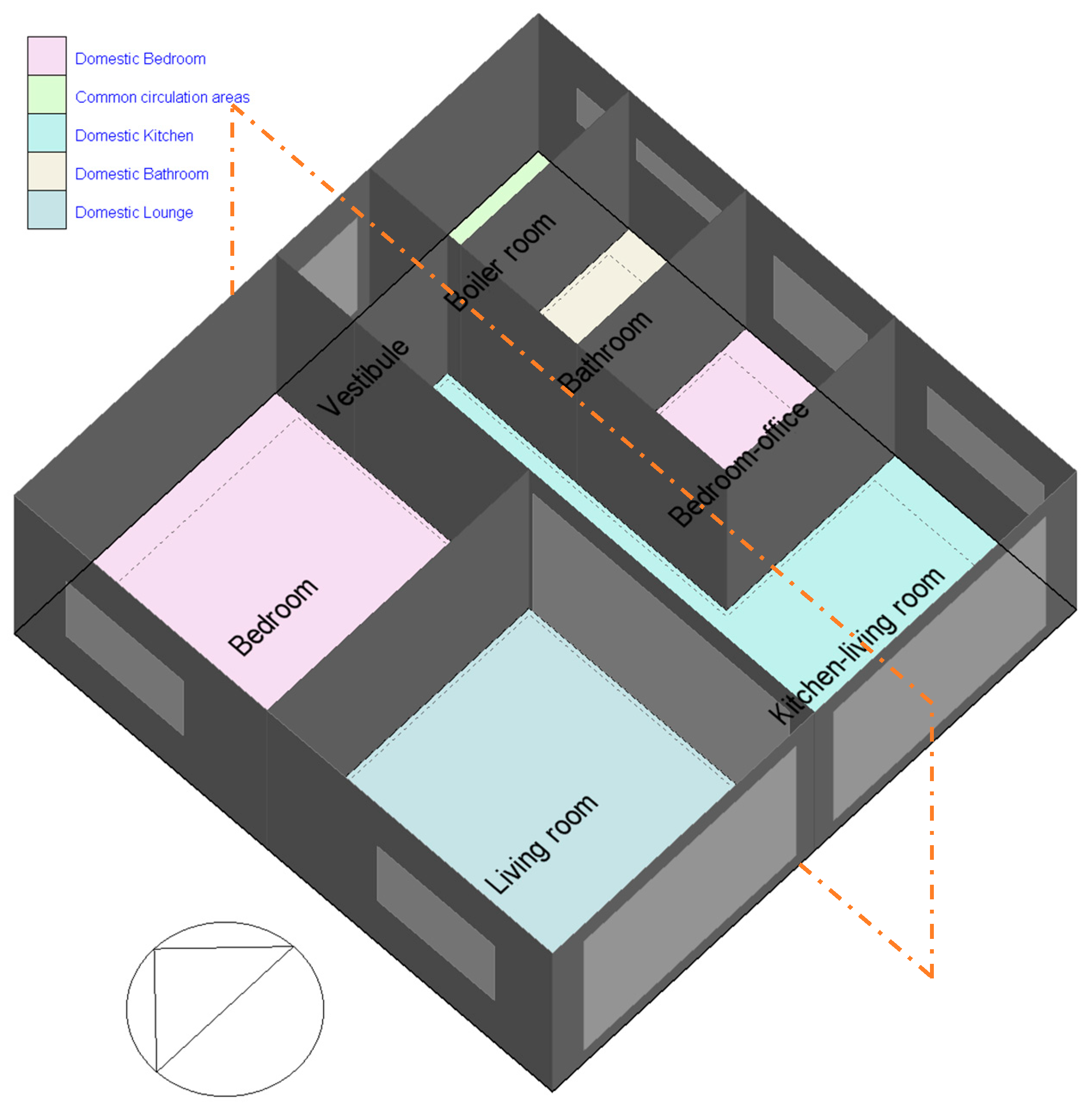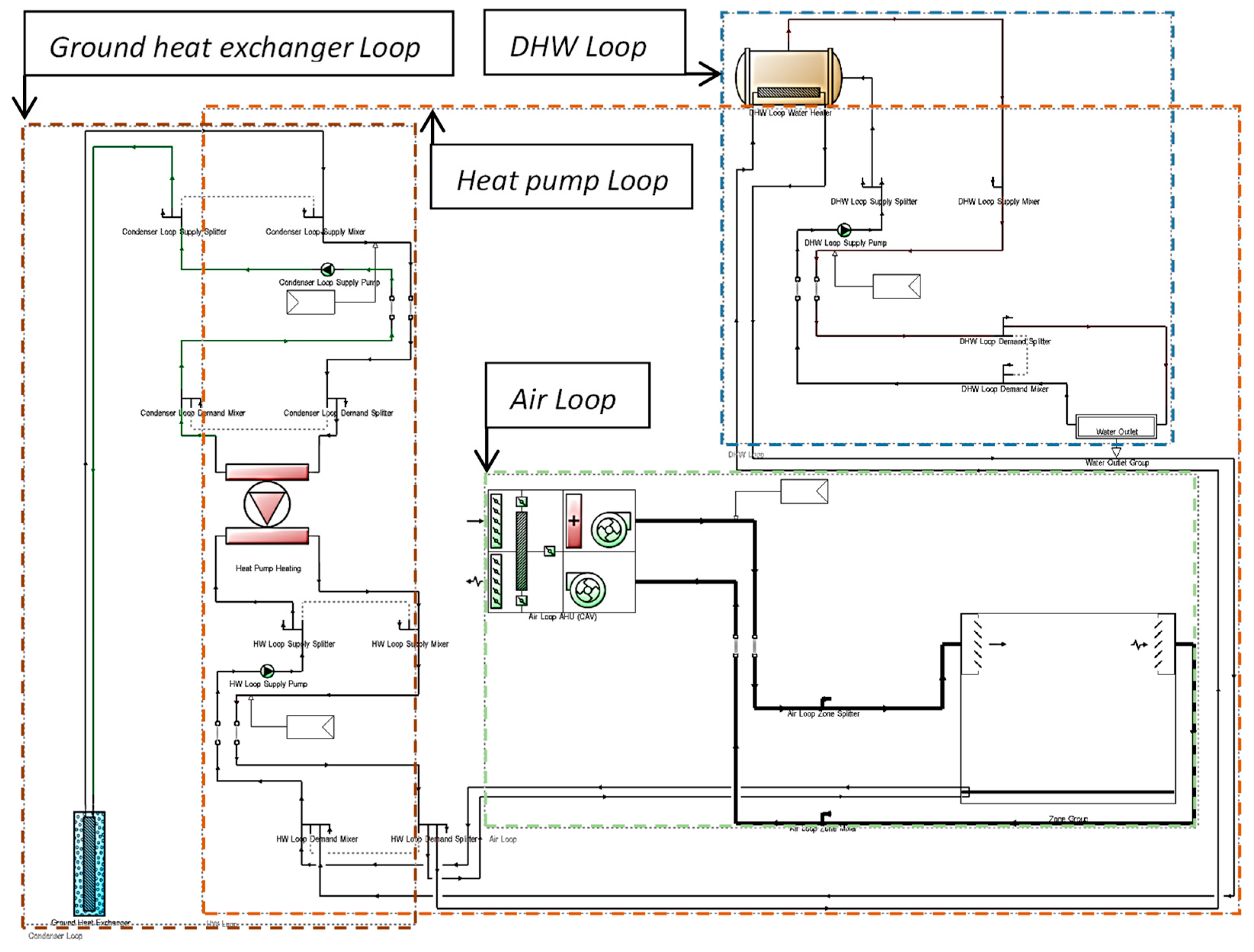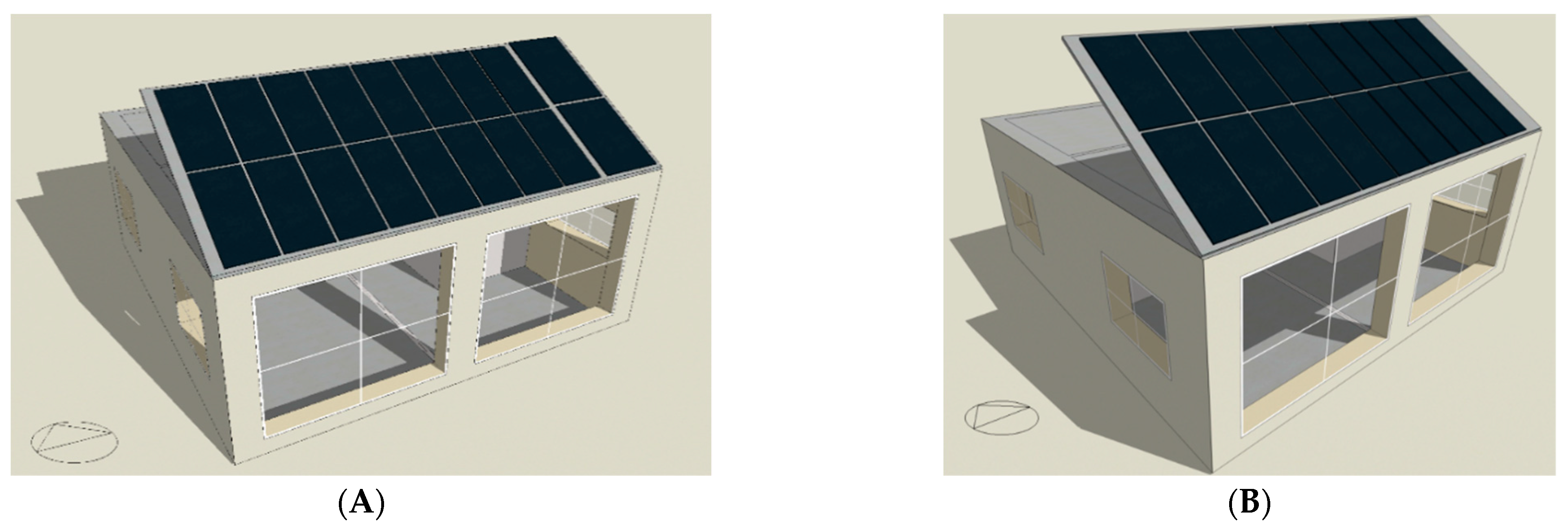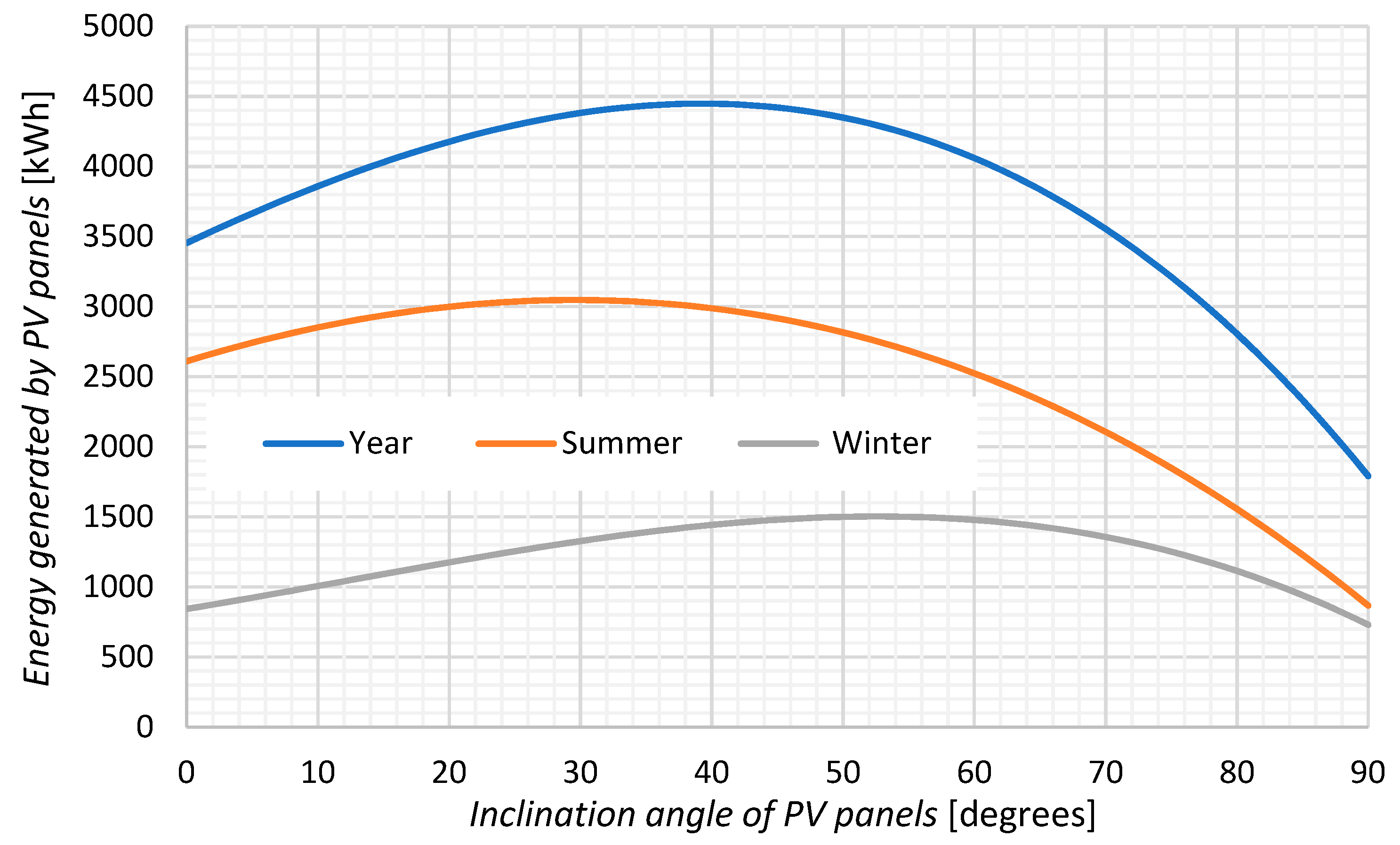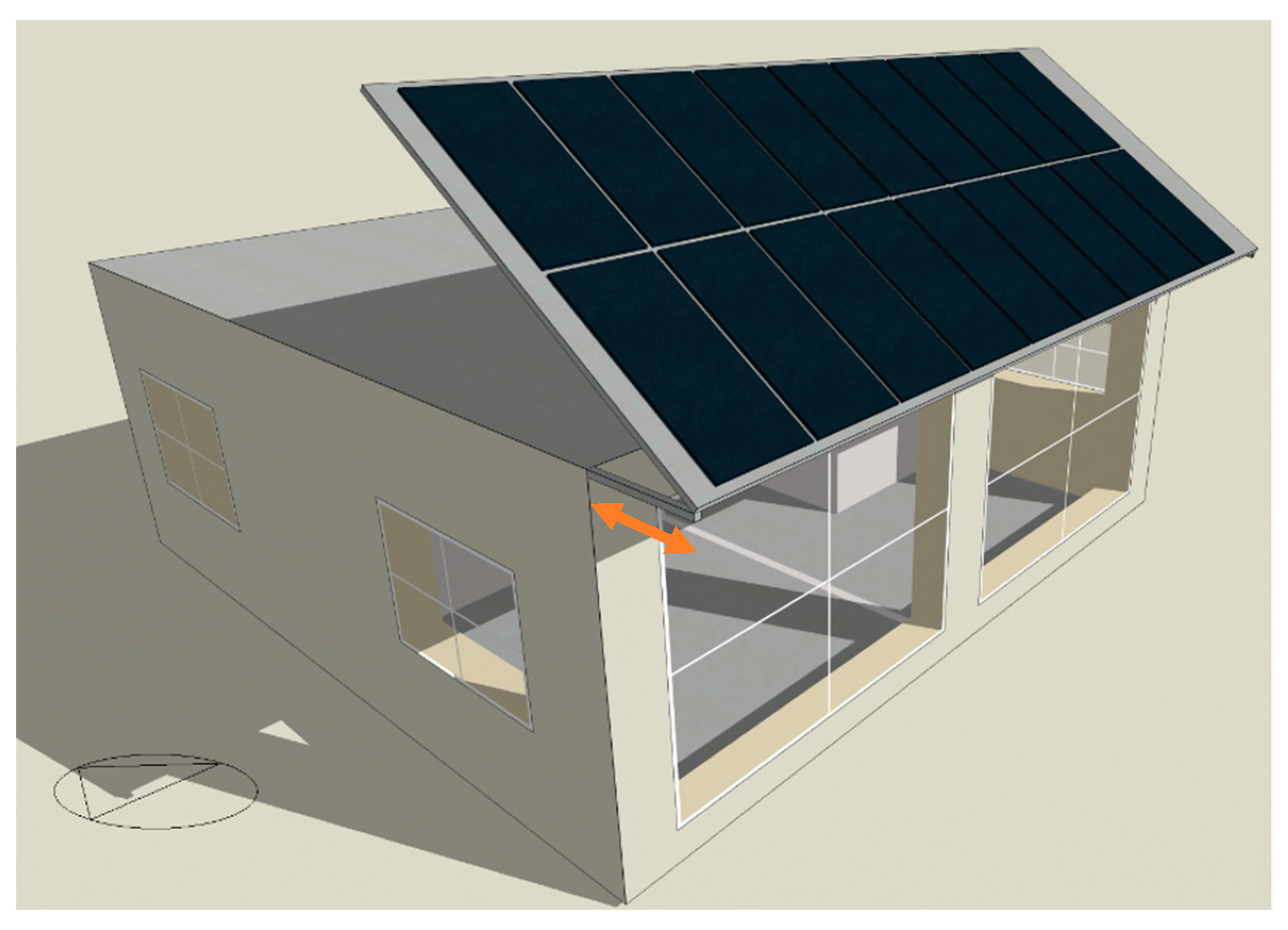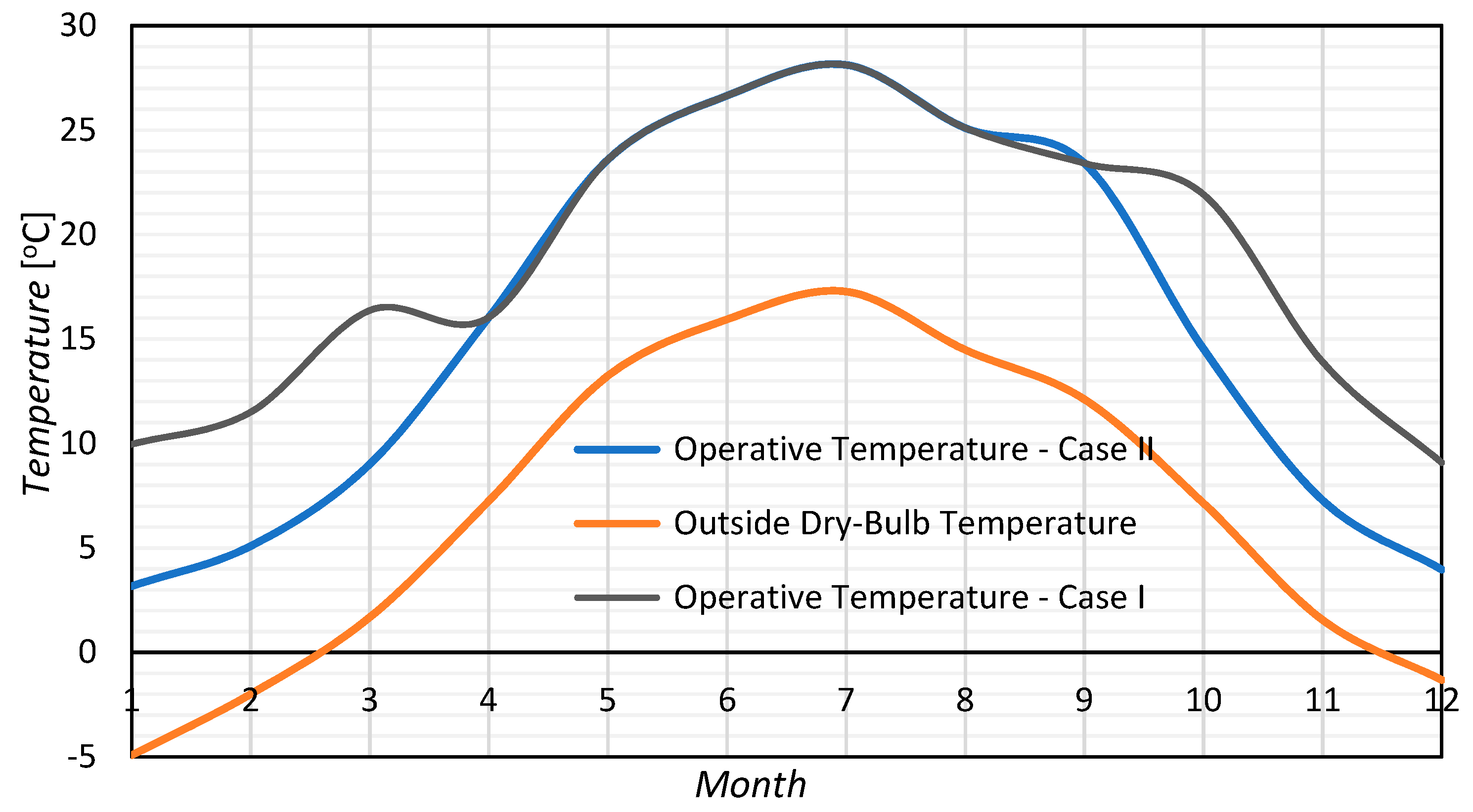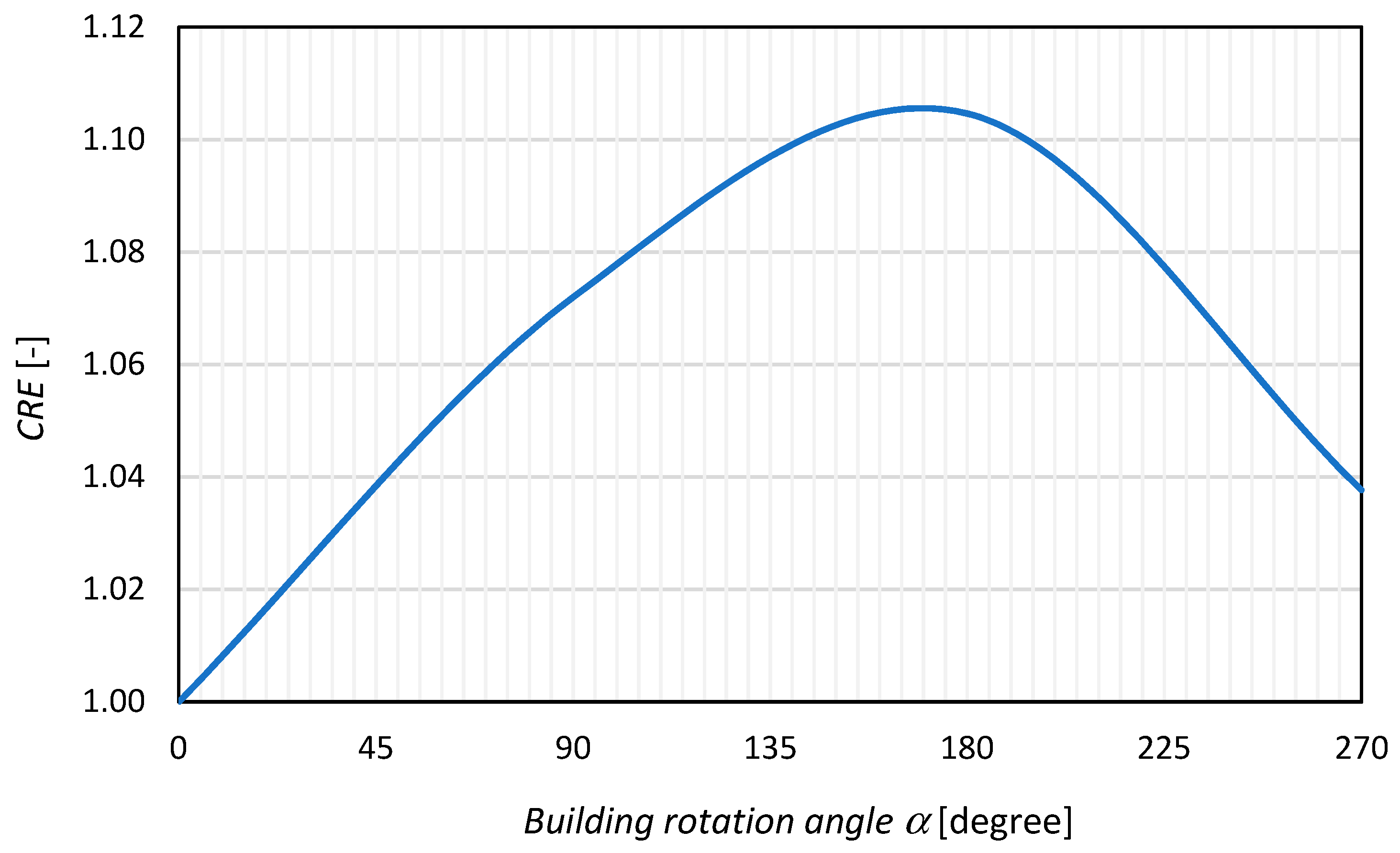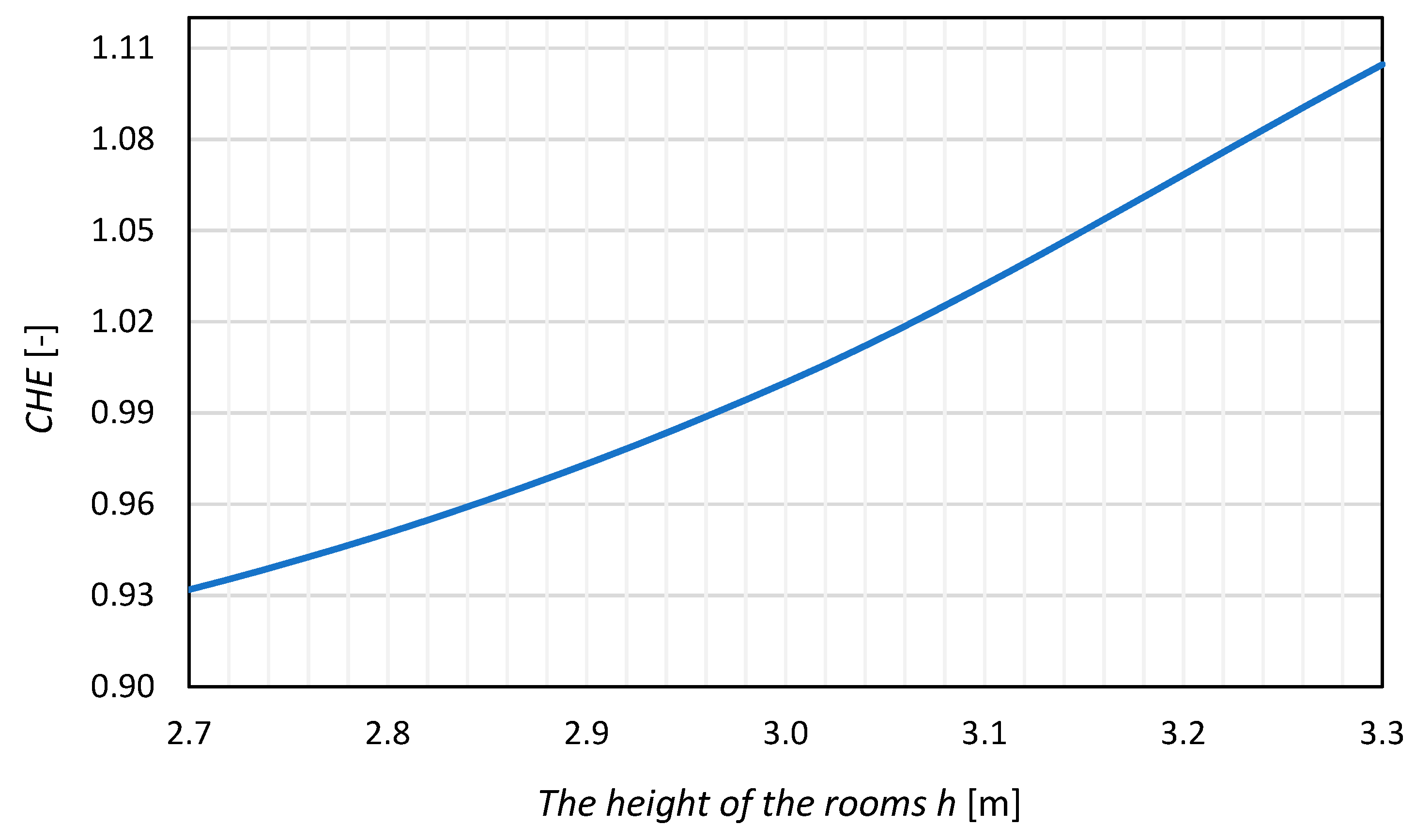1. Introduction
The events of the last two years, and in particular of recent months, have caused many people to change their life priorities and routine habits. The real threat associated with the lack of fossil fuels or their very high price has resulted in the need to reduce energy consumption in households. Building upgrades to improve the envelope energy characteristics will not result in a significant decrease in energy demands, especially when the house is located in a cold climate zone and has a large cubature. This is because the same amount of heat is still consumed to produce hot water and to heat the ventilation air. The use of mechanical ventilation with heat recovery in an existing building may cause collisions with the ceilings and walls. The aim of this article is to analyze one of the solutions that could, to some extent, increase energy security during the energy crisis.
In Poland, on 3 January 2022, a government program was introduced to mitigate the effects of the economic crisis. Among other things, a set of regulations was developed to enable the construction of a house without official authorization, a construction manager or a construction logbook. The investor can build a house with a built-up area on the external outline of up to 70 m2. The building must be detached and dedicated only to one’s own needs, so it cannot be rented out, for example. Depending on the local development plan or administrative requirements, it is possible to design a flat roof or a sloping roof with a small attic. Free architectural plans for this type of building should soon appear on the government websites. However, the investor will decide on the application of the heating, ventilation and air conditioning (HVAC) systems. This is a difficult decision due to the high competition in this industry and because a lot of the advertising materials can be misleading.
Recently, we have observed a rapid increase in the prices of building materials, and often a lack of or limited choices. In addition, the number of professional contractors continues to decline and the cost of their services is very high. Therefore, a good solution would be to buy a ready-made object.
1.1. Literature Review on Modular Building Technologies
Building a house based on modular technology is one of the most efficient off-site construction methods according to Kamala and Hewage [
1]. Individual parts or the entire building, depending on the required floor space, are made together with HVAC systems in factories. Then they are transported to the construction site and placed on the previously made foundations.
Prefabricated houses can also be quickly used in the event of natural disasters. The level of thermal comfort in such facilities was analyzed by Wang et al. [
2]. The simulation model was developed in the EnergyPlus software environment and validated by comparison with the experimental results. In one of the main conclusions, it was stated that the most effective measure to lower the air temperature inside this type of house was the use of external window blinds.
The use of a Sim (PLY) framing system to build a small house prototype for student communities was developed by Albright et al. [
3]. This technology is based on the production of plywood prefabricates with the use of CNC machine tools. The building in the Sim (PLY) framing system can be assembled by the average person and then can be easily disassembled, and the construction elements can be reused.
Remote work has proven to be advantageous both in terms of energy savings and for many in terms of providing a new way of life. These new habits are now being promoted by many large companies because of the savings associated with them. Some remote work experiences have led some municipalities in Italy to support settlement in less popular locations. These conditions can lead to a kind of “climatic nomadism” that can be achieved through the use of mobile houses. The pandemic crisis in 2020 and 2021 inspired Roggeri et al. [
4] to develop a portable modular building made of a timber frame system. The modular frame allows for its easy adjustment and provides various configurations that result from the individual needs of the user. Computer simulations performed using the BIM/BEM methodology showed that this type of building can be zero-energy in the climatic conditions of Italy.
Jiang et al. [
5] formulated conclusions and recommendations related to the promotion of the use of prefabrication as an effective alternative to conventional construction. The researchers identified sixteen indicators in order to reliably compare and evaluate both methods of building houses. The real-coded accelerating genetic algorithm was used as a research tool, which demonstrated the sustainability of the prefabrication process.
Scientific research on the potential environmental benefits of using innovative modular design solutions was carried out by Gunawarden et al. [
6]. In the first part of this work, the authors reviewed prefabricated modular technologies and compared them with conventional house-building methods. TRNSYS software was used for an energy analysis of structures made of steel, concrete and wood. The result of the analysis was that a precast concrete building is more than four times heavier than a precast steel building. However, the energy used for the production of steel and the construction of a house with this technology is about 50% higher compared to prefabricated concrete. On the other hand, the comparison of an object made of wooden prefabricated elements combined with a steel structure and a concrete building showed that the total embodied energy is about 10% higher in the first case. This analysis concerned only the building structure and did not include HVAC systems.
We are dealing with severe weather phenomena related to climate change more and more often. Hurricanes and tsunamis result in extensive damage to homes. One example is the effects of Hurricane Katrina, which left tens of thousands of families homeless. The answer to this type of crisis may be modular construction, offering houses with a small area but also at a low cost [
7]. Homes such as the “Katrina cottage” and “coastal cabana” [
8,
9] can be used as alternatives to the trailers provided by the Federal Emergency Management Agency (FEMA trailers).
A similar project to develop compact and modular residential buildings is currently underway in Poland. The reason for their development is the influx of over 5.3 million refugees caused by the war in Ukraine (August 2022). The first containers for refugees from Ukraine were installed in Bialobrzegi (Poland) in April 2022. They consist of separate rooms, shared bathrooms and a kitchen. In April 2022, a container town for war refugees from various parts of Ukraine was established in Stryjski Park in Lviv (Ukraine). The housing estate consists of 88 accommodation units that are heated, furnished and connected to electricity. A similar container town was built in Borodzianka near Kiev (Ukraine) for 350 residents who lost their homes as a result of the Russian invasion.
A comparison of a small house of approximately 40 m
2 with a residence of approximately 225 m
2 (near the regional average) in California (USA) was made by Harkness [
10]. This research covered energetic, technical and economic aspects. EnergyPlus software was used for the building’s energy modeling. However, the simulation of the operation of HVAC systems was performed only in a simplified way. The results of the comparative analysis showed that tiny homes can have up to 85% lower energy requirements compared to standard buildings with an average regional floor space.
The Stockholm Tiny House Expo is planning to create an artificial island with several small houses in the vicinity of Stockholm (Sweden). This housing estate will be self-sufficient in terms of energy and the island should adapt to changes in sea level. Björnberg and Tarus [
11] used the IDA ICE and HOMER Pro software programs to simulate the demand, production and distribution of energy on the island. As in the previously cited paper [
10], this analysis also did not model the operation of HVAC systems in detail. Eight different energy supply and demand scenarios were simulated and assessed in terms of the technical, economic and environmental aspects. The results of this study showed that buildings can be energy self-sufficient using renewable sources of energy. However, this approach turned out not to be economically profitable.
Based on a very extensive review of the literature, it should be stated that a lot of research has been carried out in terms of the prefabrication methods and technologies. The research has focused primarily on the development of new technical solutions related to the construction of building partitions, the methods used for combining them into modules and ensuring the strength of the entire structure and their transport to the construction site. However, only a very small number of studies have covered the dimensioning of heating and ventilation systems in modular buildings and energy analyses of buildings together with HVAC systems under operating conditions.
1.2. Literature Review on Reductions in Heat Energy Consumption
Another broad and complex issue covered in this paper is the minimization of energy consumption in residential buildings. Climate change and energy crises have forced the governments of the most economically advanced countries to develop zero-energy strategies. Kibert and Fard [
12] noted that both the United States and the European Union (EU) lack standard requirements for low-energy buildings and net-zero-carbon buildings, as well as definitions for net-zero-energy. In their article, they cited many publications that give different definitions of these terms and made many constructive comments related to them.
Eight single-family house modernization projects were analyzed by Galiotto et al. [
13] in terms of minimizing energy consumption. Three houses in Denmark, three in Switzerland and two in Austria were selected for a multi-criteria overview of retrofitting possibilities. The authors distinguished passive and active measures that were taken to reduce the energy consumed. They included the first types of measures, such as the passive use of solar radiation, geothermal energy, thermal insulation for building envelopes, automatic control and heating system changes from high-temperature to low-temperature systems. The photovoltaic system and thermal solar collectors were classified as active measures. As it turned out, the main motivations for the homeowners selected for this study were lowering their operating costs, improving their health and thermal comfort, wanting a sustainable home and wanting to expand their home. As it turned out, the cost side of the modernization projects was not the main decision-making factor.
Caruso et al. [
14] analyzed the possibility of obtaining the net-zero-energy building (NZEB) standard for a seven-apartment residential house in Mediterranean climate conditions. It was a terraced house apartment building, which is typical for Italy, with an area of 435 m
2 and a cubature of 1670 m
3. The mean value of the heat loss coefficient for the external partitions was 0.55 W/(m
2K). Dynamic simulations with EnergyPlus software were used as a research tool. In the first phase of this analysis, the year-round rate of primary energy consumption was determined, which was 79 kWh/m
2 for the whole building. In order to reduce the demand for electricity, the authors proposed the use of 87 m
2 of PV panels, 20 m
2 flat plate solar collectors and a demand-controlled ventilation system with heat recovery. Thanks to these projects, the apartment building achieved the NZEB standard theoretically. According to the authors, the case considered in their analysis was representative of the area of southern Italy, so the conclusions may be universal for building design in the whole region.
The test procedure for minimizing energy consumption in winter and summer without deteriorating the level of thermal comfort was performed by Ascione et al. [
15]. The objects of the research were single-family, one-story buildings with an area of 140 m
2, consisting of 7 rooms and located in four cities: Madrid, Nice, Naples and Athens. Several variable parameters were assumed for the optimization process, such as the technology used for the external walls and roof, the optical and thermal characteristics of the glazing system, the window shading method and the window-to-wall area ratio. Building performance simulations were made in the EnergyPlus software environment. As a result of the calculations, numerous conclusions have been formulated, on the basis of which architects can design a nearly zero-energy building (nZEB). One of the criteria for reducing energy demands is the use of external walls with a thermal mass
Ms greater than 250 kg/m
2, made of aerated concrete bricks or blocks with integrated thermal insulation. On the other hand, a brick concrete roof should have an even higher mass
Ms equal to about 500 kg/m
2 and a heat transfer coefficient of 0.16 W/(m
2K). Reductions of cooling demands of between 2% and 13% are possible thanks to the use of phase change materials as the finishing layers on the inner sides of the walls, with a melting temperature of 25 °C. This analysis did not take into account the influence of the type of heating and ventilation system on the energy performance of the building.
The aim of the work by Lobaccaro et al. [
16] was to minimize greenhouse gas emissions and energy consumption in a zero-emission building in Oslo (Norway). An optimization analysis was performed with a graphical algorithm editor Grasshopper integrated with Rhino’s 3-D modeling tools [
17]. The results of the energy simulations made in the DesignBuilder environment [
18] were also used. The object of the research was a single-family, two-story building with dimensions of 8 m by 10 m, which was used to reach the level of ZEB-OM [
19,
20]. The ZEB-OM shortcut means that the production of energy from renewable sources can compensate for the emissions of greenhouse gases generated during the operation of the building and resulting from the production of building materials. The multi-objective optimization process involved changing building elements such as the shape, amount of building materials and dimensions of the structural elements. The environmental impact was determined for each variant by estimating the emissions and energy demands. The result of the analysis was the selection of the best ten house shapes at high latitudes that will enable the optimal use of solar radiation. The authors proposed a universal approach to designing energy-efficient buildings with minimal environmental impact that can be constructed in any climatic condition.
Soltaniehha et al. [
21] analyzed the possibility of achieving the NZEB standard in US climatic conditions. The subject of the study was a two-story rectangular house without a basement or garage, which consisted of 3 bedrooms, 2 bathrooms and an office. The calculations were performed with a software package consisting of DesignBuilder, Autodesk Ecotect and Autodesk Vasari. The shape of the building, its orientation towards the direction of the world and the type and percentage of glazing were modified in order to achieve the minimum energy consumption. The roof surface was considered for the installation of systems for converting solar radiation into electricity and heat. The simulation results showed that the most economical solution is to use photovoltaic panels cooperating with a heat pump with a COP equal to or higher than 2. In some climatic conditions (for example in the immediate vicinity of Denver), southern glazing is effective in reducing the energy consumption, which was another conclusion of this analysis. On the other hand, in cold climates, the enlarged southern glazing causes greater heat loss than the heat gain from the solar radiation.
1.3. Main Goals, Hypothesis and Novelty Elements
The studies presented above concerned buildings with a relatively large area, as compared to the residential module analyzed in this article. The specificity of such facilities involves the different shares of energy consumption for heating, ventilation, domestic hot water (DHW) and lighting. The shares of heat gain from residents and solar radiation in the energy balance were also different. The main purpose of this article is to determine the characteristics of the small modular building developed by the author and the impact of various heating and ventilation technologies on energy consumption.
The energy simulations were performed for both the heat transfer through the building envelope and the operation of HVAC systems. In the vast majority of analyses of this type, this last aspect is ignored. The element of novelty involves the determination of the optimal slope angle of the solar collectors depending on the season in the considered location and the local climatic conditions. The influence of the supporting structure of the PV panels on the increase in energy consumption caused by the shading of the glazing on the southern facade of the building was also determined. The analysis of the thermal conditions in the modular house when the heating was turned off in winter can also be treated as a novelty. The recent events in Ukraine, related to the bombing of the infrastructure of the district heating system in mid-October 2022, prove that the content of this paper is very up-to-date.
The main objective of this study was to design a small modular house and a dedicated heating and ventilation system that would be characterized by minimal energy consumption. This article considers the research hypothesis that it is possible to obtain a zero balance of energy losses and gains in a small residential building in relatively severe winter climatic conditions.
2. Materials and Methods
Energy simulations of the building envelope and HVAC systems were used as a research tool to perform the analysis of a small modular house.
2.1. Energy Model of the Building and HVAC Systems
The modeling of transient heat transfer and the operation of HVAC systems in a modular building were achieved in the DesignBuilder Version 6.1.5.004 software environment. First, a three-dimensional model of the house envelope consisting of two modules of the same size was developed. The plane of division (south–north) running through the center of this structure is marked with an orange dashed line in
Figure 1. The arrangement of the rooms in both parts can of course be optional.
The two modular building consist of six rooms, two of which, the vestibule and boiler room, are unheated and are not served by mechanical ventilation. Their characteristics are presented in
Table 1. These types of modules can be combined in a number of pieces and also with different orientations. Of course, the layout of the windows in this situation must be changed.
The heat transfer coefficients of this building partitions, calculated according to the standard EN ISO 6946:2017-10 [
22], are the following: external walls—0.139 W/(m
2K); flat roof—0.107 W/(m
2K); ground floor—0.177 W/(m
2K); windows—0.78 W/(m
2K); total solar transmission—0.474; direct solar transmission—0.358. The structure is made of a wooden material insulated with extruded polystyrene. The building is located in Bialystok (north-eastern Poland), and its latitude is 53.1° and longitude is 23.17° (city center).
In order to achieve the lowest possible consumption of primary energy, one should not be limited only to the use of thick thermal insulation for the building envelope. As is well known, systems using renewable energy sources can also contribute to the achievement of this goal. Solar radiation, the energy accumulated in the ground and the outside air were taken into account when developing the energy supply concept for this single-family building. It was decided to consider the heating system and DHW system separately in order to make the optimal decision when choosing the variant requiring the lowest primary energy demand. This assumption complicated the analysis, but the decision was also caused by the different operational characteristics of both technologies. In the case of heating, the system supply temperature is a function of the outdoor air temperature, while DHW heating requires a constant supply temperature throughout the year. In the case of the heat pump operation, this parameter is very important and has a large impact on the seasonal coefficient of performance (SCOP). Thus, the following variants of energy supply systems were analyzed:
The following systems for preparing domestic hot water are proposed:
Variant III—Air-to-air heat pump.
Variant IV—Air-to-water heat pump (AWHP).
Variant V—Ground source heat pump.
Variant VI—Solar domestic hot water (SDHW) with 2 solar thermal collectors (STC).
In the technical solutions proposed above, the source of energy is electricity. Therefore, the amount of energy produced from the photovoltaic panels was analyzed:
Variant VII—Photovoltaic (PV) system—18 PV panels.
Selected diagrams of the systems using renewable energy sources are shown in
Figure 2,
Figure 3 and
Figure 4. It was assumed that the mechanical ventilation system would be equipped with a recirculation and recuperation system. The minimum outdoor flow rate was 0.015 m
3/s and the maximum outdoor flow rate was 0.02 m
3/s, while the minimum limit of the economizer dry-bulb temperature was 11 °C and the maximum limit was 25 °C. It was also assumed that the efficiency of the heat recovery system was 75%.
The ground source heat pump was equipped with 4 U-tube boreholes, each 75 m long. The seasonal coefficient of performance was 4, the maximum loop temperature was 55 °C and the thermal conductivity of the ground was 0.693 W/(m K).
The solar domestic hot water system was equipped with two thermal collectors with an area of 2 m2 each (in total 4 m2). The maximum flow rate through the collectors was 0.00005 m3/s, and the parameters for the efficiency equation were as follows: 0.75 (coefficient 1), −2.92 W/(m2 K) (coefficient 2), −0.0178 W/(m2 K2) (coefficient 3). The capacity of the hot water storage tank was 100 liters.
The PV system consisted of 18 panels with an area of 1.32 m2 each (in total 23.76 m2). The characteristics of one module were as follows: cells in series—36; rated electric power output—250 W; transmittance absorbance product—0.9; heat loss coefficient—30 W/(m2·K).
The method of arranging collectors for converting solar radiation into heat and electricity at an inclination angle of 30° is shown in
Figure 5. In a simpler option, the PV panels can be arranged in two rows on a flat roof.
2.2. Main Assumptions for Modeling
The energy simulations for this house and its HVAC system were achieved with the most important assumptions listed below:
The meteorological database POL_BIALYSTOK_IMGW (WMO station identifier 122950) was used for the calculations. The climate parameters are as follows: the annual average temperature of external air is 6.92 °C, the summer average temperature is 13.4 °C, the average winter temperature is 0.4 °C, the maximal difference monthly average external temperature is 22.17 °C and the solar radiation intensity on a horizontal surface is 882.3 kWh (702.33 kWh in summer, 179.98 kWh in winter). To describe the climatic conditions of this case study in more detail, the Köppen classification is used to quantify the climate variability. According to the Köppen weather types, north-eastern Poland is in a humid continental climate zone, denoted as Dfb. In the ASHRAE nomenclature, this is climate zone 6A;
Two adults and a child live in the house and use 48.52 m3 of DHW per year;
The people’s clothing parameters are 1.0 clo in winter and 0.5 clo in summer;
The activity factor used to calculate the metabolic rate is 1 for men, 0.85 for women and 0.75 for children;
The people’s activity is declared according to schedules that depend on the type of room;
The parameters of the indoor climate are calculated as a function of the residents’ activity schedules, ventilation air flow rate and outdoor air parameters. It is only assumed that the heating system provides an indoor air temperature of 20 °C in the rooms and 24 °C in the bathroom. Other factors characterizing the indoor climate, such as the air humidity, CO2 concentration and operating temperature, are calculated by the software from the energy and mass balance equations;
The cooling of the building during the summer is considered only as free cooling.
3. Results and Discussion
The energy simulations of the building envelope and HVAC systems of a small modular house were performed using many variants. The results of these calculations and the discussion are presented below.
3.1. Determining the Energy Performance of a Building in the Base Variant
The primary energy
EP is defined as the energy harvested directly from the natural resources in the energy assessment of the buildings. The annual non-renewable primary energy demand for technical systems is determined by the following formula:
where
EP−H is the annual demand for non-renewable primary energy for the heating system [kWh],
EP−DHW is the annual demand for non-renewable primary energy for the domestic hot water heating [kWh] and
EP−E is the annual demand for non-renewable primary energy for electricity [kWh].
However, in the first calculations, it is necessary to estimate the demand for the final energy, i.e., the total energy consumed by end users. In the base variant (variant 0), it was assumed that the house is powered in the currently most popular way in Poland, i.e., from a dual-function gas boiler and from the power grid.
The final energy consumption in this case is
EF−H = 2692.38 kWh (heating and ventilation needs),
EF−DHW = 2389.93 kWh for the domestic hot water (DHW) and
EF−E = 623.81 kWh electricity for the lighting and pump drive. To convert the final energy demand
EF into the primary energy
EP, the following relationship should be used:
where the conversion coefficient
PEF is the primary energy factor. The list of conversion factors for primary energy in the current practice to estimate the energy performance of a building was presented in the article by Sartori et al. [
23] for various countries. The current value of
PEFE for electricity generation and the grid supply is 2.5 [
24] in the countries associated with the European Union. This value should probably decrease to 2.1 in the near future. The value of the conversion factor
PEFG for natural gas as a fossil fuel is assumed to be 1.1. Thus, the amount of primary energy consumed by this modular building in the base variant
EP-W0 is calculated from Equation (2) and equals 7150.07 kWh. The conditioned area of the rooms is 51.31 m
2, i.e., the primary energy use per square meter of the floor area is 139.35 kWh/m
2.
The building energy rating (BER) allows a specific assessment of the energy performance of a building. In this analysis, the following levels of primary energy consumption in kWh/m2 were used to estimate those six variants:
Therefore, the building under consideration can by classified as B3. This level of energy use is relatively low, despite the use of highly resistant thermal insulation for the external partitions. Changing the traditional technological solutions to those that use renewable energy sources will allow us to significantly reduce this rating level. It should be noted that in this case, the relatively high energy demand results from the low outside air temperature in winter, where the design temperature for sizing a heating system is −22 °C.
3.2. Estimation of Energy Demands Using Renewable Energy Technologies
As mentioned earlier, six variants were proposed for which the final energy demand was first estimated and then converted into the primary energy value. A series of calculations were also made that allowed us to determine the dependence of the energy converted into electricity on the angle of inclination of the photovoltaic panels. This relationship is shown in
Figure 6. All three functions are second-order polynomials with the convexity facing upwards, so it is not difficult to determine the maximum or optimal value.
For variants V and VI, calculations were made for the three collector inclination angles of 39°, 30° and 53° for the optimal values for the whole year, summer and winter, respectively. The final results of the energy simulations are presented in
Table 2.
The analysis of multi-variant simulations shows that the use of a ground source heat pump allows the energy consumption in the building to be minimized. In this case, the sum of the primary energy demands for heating and DHW purposes is 3065.33 kWh, and after taking into account the energy for lighting and the pump drive (1559.53 kWh), the total value is 4624.86 kWh. The energy demand rate is 90.14 kWh/m2 (class B1). This represents a reduction of about 35% compared to the baseline.
As we can see, this is not a satisfactory result. In order to obtain a further reduction in the primary energy consumption, it will be necessary to use photovoltaic panels and solar thermal collectors. This assumption of using renewable energy technologies (16 PV panels and 2 STC collectors) in the most effective variant, i.e., the seasonal change of the slope angle, will allow us to save 4820.13 kWh. Thus, we can obtain a slight overproduction of electricity equal to about 195 kWh during the year. In this case, the building can be called zero-energy.
A drawback of the heat pump cooperating with the ground heat exchanger is the inability to move it together with the building. If we plan to move the house, the use of an air source heat pump is a better although less economical solution. Additionally, the AAHP can be placed on a flat roof to reduce noise and save space.
3.3. Estimating the Impact of the Southern Shading Elevation on the Energy Demand
There is no cooling option in this budget building for economic reasons. Therefore, the use of all shading techniques is highly recommended. The supporting structure of the photovoltaic panels could also serve as a shading element for the southern facade of the building (
Figure 7). The use of this type of solution would ensure a reduction in heat gains from solar radiation in the summer.
Figure 8 shows the effect of the overhang projection on the heat requirement of a building and the amount of solar energy entering through the glazing. If the length of the shading element is less than 0.25 m, it practically does not affect the energy balance. On the other hand, a nearly linear increase in the heat demand can be observed, caused by the limitation of the heat gains from the sun when the overhang projection is greater than 0.25 m. We can achieve more than a 32% decrease in heat gains with a reach of 2 m. This will significantly reduce the temperature inside this small building. A further shift of the shading element was not analyzed, which was caused by design considerations.
3.4. Determining the Influence of the Glazing Area on the Energy Demand
Climatic zones similar to the one discussed in this article are characterized by low outside air temperatures and low solar radiation during winter. Therefore, it should be checked whether the use of the largest possible glazing area on the south side will not increase the heat demand. For this purpose, the influence of this parameter was analyzed by reducing the height of the southern windows by 30 cm in the subsequent calculations. The area of the other windows was not changed because this ensured the correct level of lighting in the rooms.
Based on the diagrams shown in
Figure 9, we can conclude that the southern side of the building should have as much glazing as possible. The heat gains from insolation are higher than the energy losses through windows in the winter. In the extreme case, i.e., by reducing the southern glazing by 90%, the demand for heating energy increases by 30%. For this reduction, there will be a decrease in solar gain by almost 70%.
3.5. Analysis of Temperature Changes inside Rooms without Heating
Another analysis was carried out in the extreme case of a deep energy crisis in which the building would not be heated. It was assumed that natural ventilation would be limited to the hygienic minimum, i.e., 0.2 air changes per hour (ACH) (case I). In case II, the fresh air stream provides comfortable room ventilation at 1.2 ACH. In both cases, the ACH is 1.5 over the summer term. In
Figure 10, it can be seen that the operative indoor temperature in the extreme case in January (case II) can drop to its lowest value of about 3 °C on average in the whole building. Therefore, in such climatic conditions, even very good thermal insulation of walls, triple-glazed windows and solar heat gains will not provide at least the minimal thermal comfort in the winter. The temperature in the house would drop to around 10 °C with the ventilation reduced to a hygienic minimum (Case I). This value is still uncomfortable but acceptable in for short periods.
3.6. Analysis of the Influence of the Building Rotation Angle on the Energy Consumption
It often happens that a building plot is not perfectly oriented to the cardinal directions of the world. As such, the house should be rotated in order that its walls are parallel to the sides of the plot. The
CRE rotation coefficient was used to analyze the influence of the building’s position in relation to the directions of the world on the final energy demand
EF−H:
As one might expect, turning the building 180 degrees is the least favorable option in terms of the energy demand. In this case, the final energy consumption may increase by more than 11 percent, as shown in the graph in
Figure 11.
3.7. Analysis of the Influence of the Building Height on the Energy Consumption
Buildings with a small living area may have a higher height in order to provide a higher cubature of the rooms. Another analysis examined how the changes in the height of the modular building would affect the final energy consumption. Another coefficient
CHE was introduced, defined as:
The reference value for these calculations was the energy consumption for the heating and ventilation
EF−H, h = 3 m of the building analyzed in this study, which was 3 m high. From the course of the chart shown in
Figure 12, it can be concluded that an increase in height of the rooms by 10 cm increases the heat loss of the modular house by about 3.5%.
4. Summary and Conclusions
This article presents the results of the preliminary energy simulations of a modular single-family building. The aim of this project was to test the feasibility of designing a tiny home with a zero-energy balance over an annual period. The first reason for dealing with this topic was the constantly growing energy crisis, which is caused, among other factors, by the rising prices of fossil fuels. The second and the most important factor was the interruption of natural gas supplies to Poland as a result of the breach of contract agreements with Russia.
The energy simulations of the proposed research object were not limited only to the calculations of the heat exchange between the building envelope and the external environment. The calculations also take into account the operation of heating and ventilation systems supported by renewable energy sources. The most important conclusions resulting from the analysis are presented below:
The case building has an energy consumption rate of 139.35 kWh/m2, so it can be classified as B3. Such a high consumption of primary energy per square meter of the floor area is due to the fact that a gas-fired boiler was used and the electricity was supplied from the power grid;
The ground source heat pump turned out to be the best technological solution for heating and DHW production. The primary energy demand was reduced by 35% compared to the baseline. The energy consumption rate decreased to 90.14 kWh/m2 (class B1);
The use of renewable energy technologies (16 PV panels and 2 STC collectors) allowed about 4820 kWh of energy to be produced. Thanks to this solution, the house can be classified as a zero-energy building;
This type of building may overheat in summer. The use of an overhang on the south side of the facade may reduce the solar heat gains by up to 30%, which will increase the thermal comfort at this time of the year. It was assumed that a sliding support structure for the PV panels could be used as the shading option;
A large window area on the south facade is recommended in moderately cool climate conditions. The gains from solar radiation are higher than the heat losses through glazing. However, the windows must be characterized by a low value of the heat transfer coefficient (triple-glazed, low-emissivity coatings and insulated frames);
This article also analyzed a scenario in which the heating system would not work. In the first case, when the natural ventilation is limited to the minimum (0.2 ACH), the indoor air temperature may drop to 10 °C. However, if the conditions for comfortable ventilation are met (1.2 ACH), the internal temperature will be around 3 °C in January;
The optimal angle of inclination of the solar collectors located in north-eastern Poland was determined. The values are 39°, 30° and 53° for the year, summer and winter, respectively.
Performing an economic analysis based on the selection of the optimal heat source would be a valuable addition to this work. However, in this time of increasing energy crises, the price of HVAC systems continues to rise in Poland. For example, in the first quarter of 2022, there were increases in the price of heat pumps by over 30% and the cost of making ground heat exchangers by about 25%. A more rapid increase in prices occurs for fuels used for heating. The purchase price of the most popular type of coal in Poland increased almost three-fold during the year. A similar tendency applies to wood pellets; moreover, a large deficit appeared at the end of this winter. In addition, in the second quarter of 2022, there was also an unfavorable change in the government policy related to the development of electricity producers from PV panels. To sum up, performing a proper economic analysis under these conditions does not make much sense because its results will be unreliable.
The sample housing module presented in this article should be a very effective solution in times of energy crises, weather anomalies and humanitarian disasters. The practical aspect of this study is the presentation of a comprehensive technical solution, primarily for use by designers. Based on the information presented in this article, it will be possible to design similar buildings that integrate energy-efficient housing envelopes with HVAC systems using renewable energy sources.
The main limitations of this analysis are listed below:
Limiting the energy simulations to only one climate zone;
The assumption of a fixed number of inhabitants;
The determination of the efficiency of a ground source heat pump for one type of soil;
The assumption of a single value of the DHW design temperature;
Not taking into account four-pane windows;
No consideration of hybrid photovoltaic–thermal (PVT) collectors.
However, it should be noted that increasing the number of analyzed parameters would generate a very large number of variants. This could significantly worsen the readability of this article, and at the same time would not have a significant impact on the quality of the analysis.
This study is the first step in a larger project. Its purpose is to prepare initial assumptions related to the construction of a modular show house. The results of this analysis will be used to develop a grant application within the Horizon Europe Program together with the Hamburg University of Applied Sciences, involving a local producer of residential modules, which is one of Europe’s largest producers.
